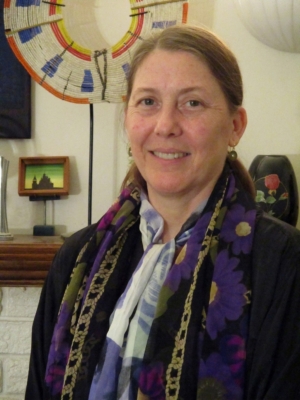Scenes from Ballets Never Staged- Acrylic
Artist Statement
My subject is dance. I have chosen as a vehicle a theatrical world of my own invention. My earlier incarnation as a dancer has greatly influenced my approach to painting. I try to show how it feels to dance, not only how it looks to an audience. I have drawn on the immediacy of modern dance, 20th century ballet, and the history of innovative collaboration between choreographers and visual artists. My work has been influenced by Merce Cunningham’s Summerspace, with sets and costumes by Robert Rauschenberg, and the scene designs of Sonia Delaunay, and those of Pablo Picasso for Sergei Diaghilev’s Ballets Russes.
These theatrical scenes are inspired by my Filipino ancestry and by The Darangen: the epic poetic narrative of the Maranao people, as well as by the textile traditions of the Southern Philippines. Each of these scenes attempts to capture and articulate the narrative imagery recovered from the psyche: a scene interrupted, a glimpse of some symbolic interior—as it might be staged in a theater. This repertoire of choreographic musings has at its center the drama of the figure framed by colors and patterns, and how the figures help reveal the shifting territory where the ancient and the contemporary collide—and what the debris (if one could collect, sort, and reconstruct it) might look like one frame, or scene at a time.
The history of the Southern Philippines, a story of resistance to occupation and a battle against cultural dilution, leads one to ruminate about the transformative experience of mind, body, and spirit—dreams of ancestors, of an identity expressed boldly in colorful dress. Deeper meditation enhances a vision of a soulful terrain—fertile ground for painting: people such as the Bagobo with a complex system of ritualistic color practice and symbolism. Warrior rankings are marked by cloths ranging from light pink for novices, to deeper browns and reds—the crimson badges of esteemed men. Priestesses weaving in ritualistic secrecy produce mythological armor. These women, artists, healers, protectors of culture worked in tandem with warriors to preserve their lands. This non-occidental color theory offers an irresistible opportunity to investigate, with new eyes, the possibilities idling on the warmer side of the color wheel. The Subanen people created mansala cloth replete with the powers of restoration; the fallen are fanned with the colorful cloth, brought back to life—a sort of reversal of the funeral shroud.
Imagining the possibilities of objects of utility that provide protection—that clothe the body, shelter the soul, and project beauty out into the world—this has led me to think of some of my paintings as metaphysical X-rays of a textile tradition. Figures in my paintings stretch, recline, recuperate, and dance. They exist in a limbo (the length of a performance) between preparing to re-enter life, or returning—if only briefly—before moving on to the next world.
Lisa Golightly Braden holds a BA in studio art from the University of the District of Columbia, and she has studied at the Corcoran School of the Arts and Design. Lisa has taught a variety of art classes and workshops at the Bender Jewish Community Center of Greater Washington, and the Corcoran Gallery of Art’s Camp Creativity. Her work has been exhibited in galleries and non-profit art spaces in Washington, DC, Maryland, Virginia, and West Virginia, including the Document Beautification Project—original works inspired by documents in the National Archives— for their museum store. And most recently, her work was included in Asia in Maryland: Expressing Cross-Cultural Experience, and she has created Pocket-Sized Originals for the museum store at the Baltimore Museum of Art.





